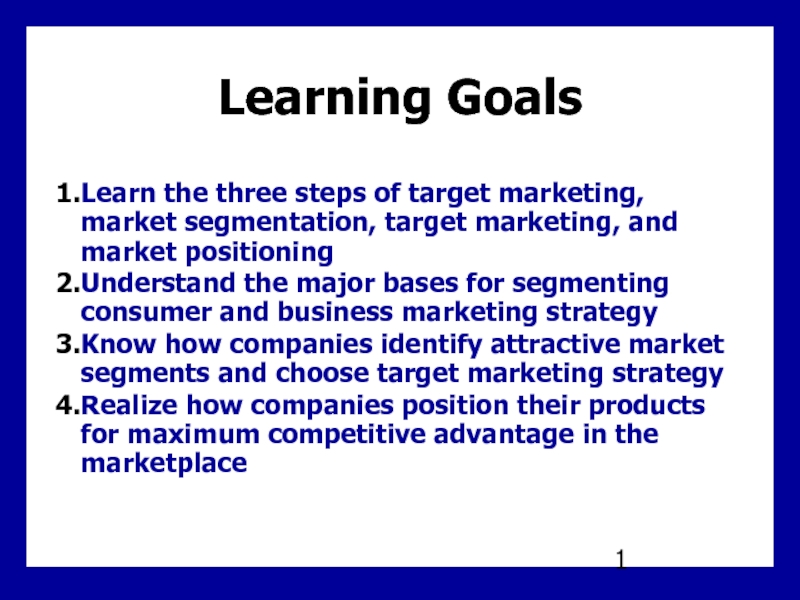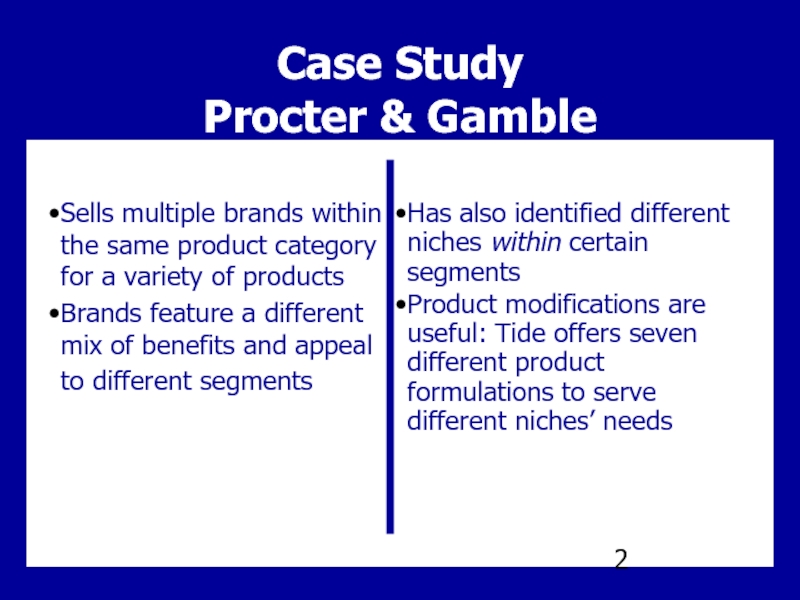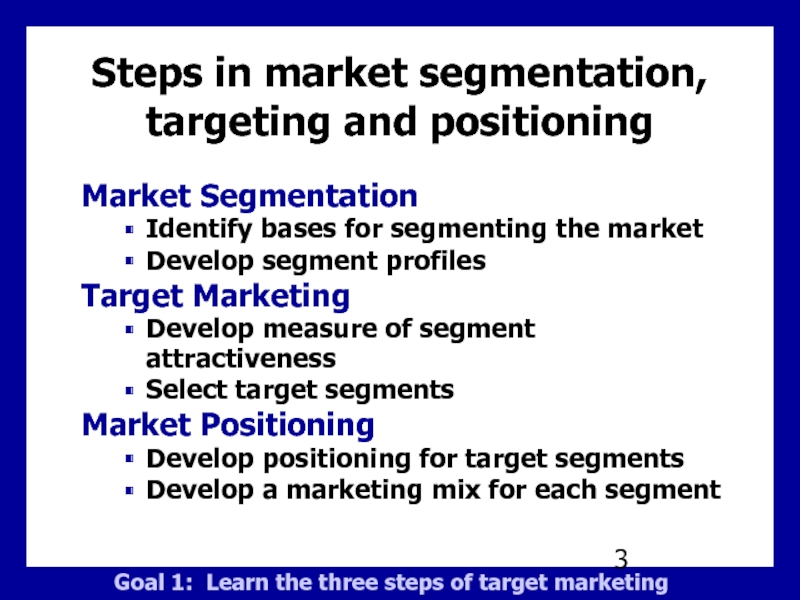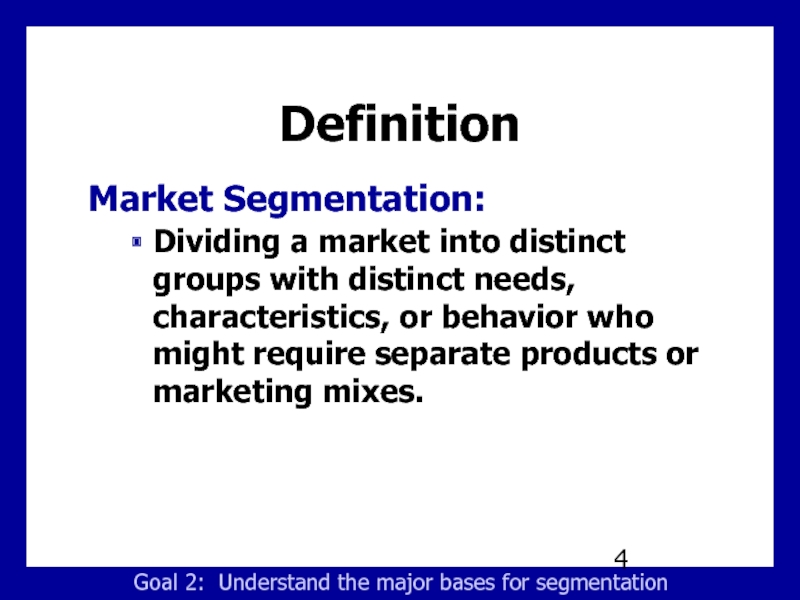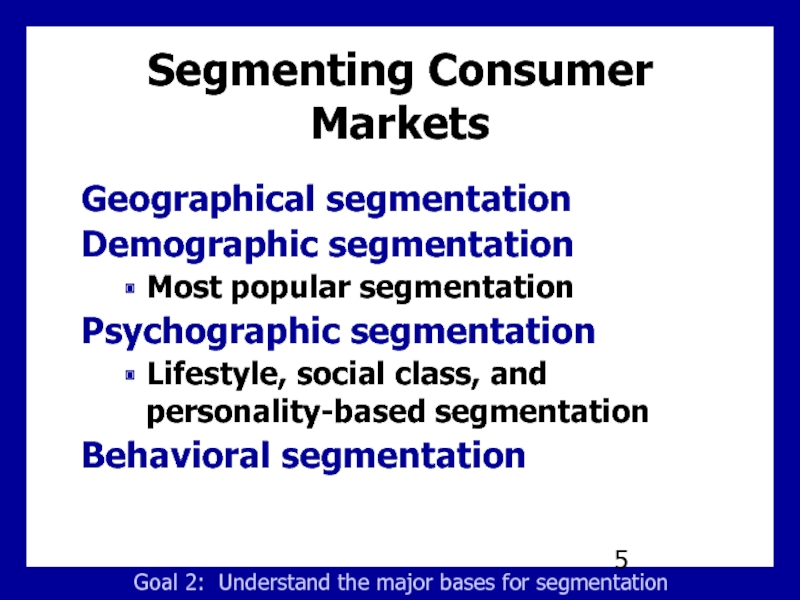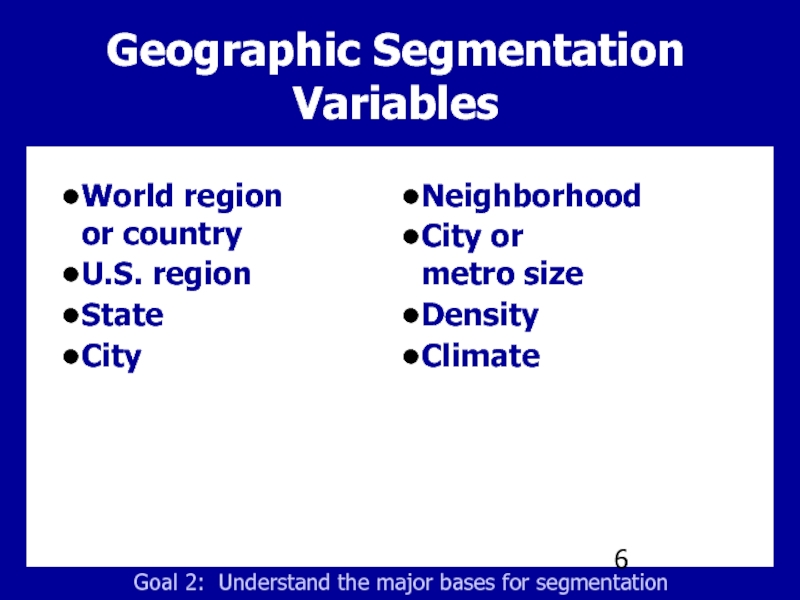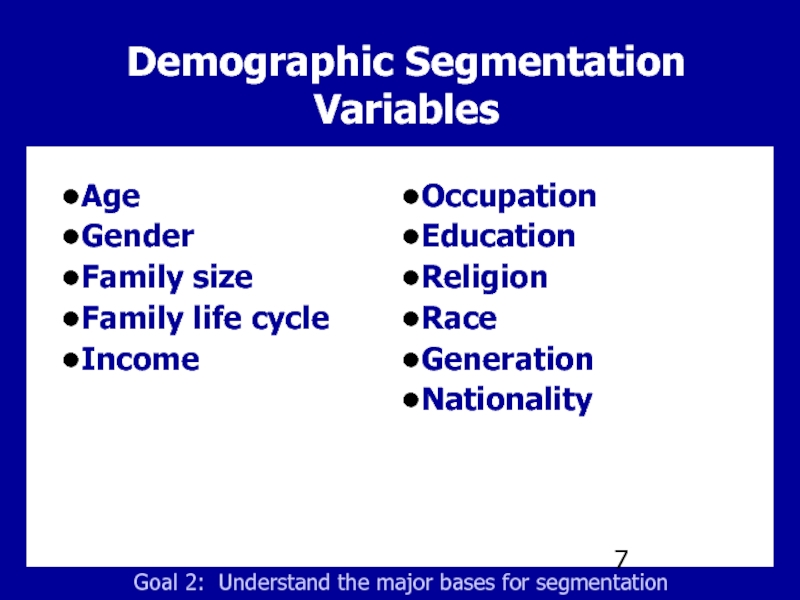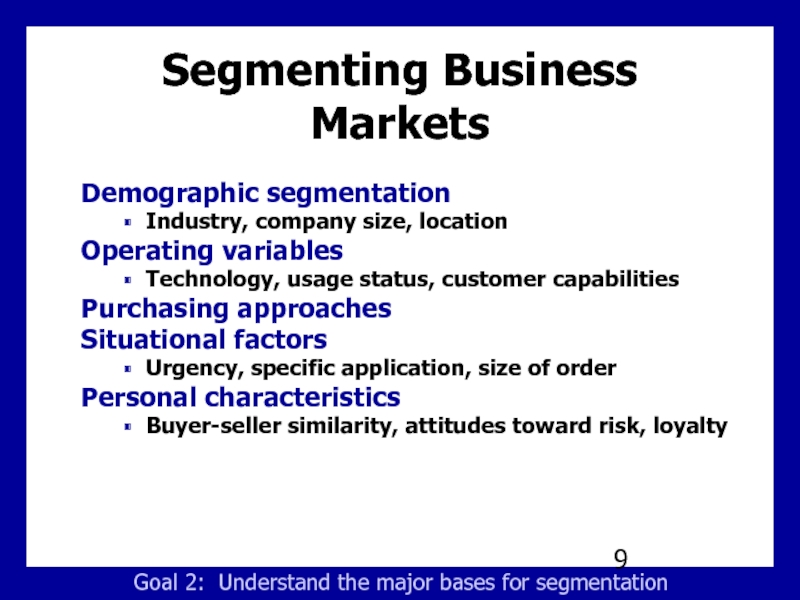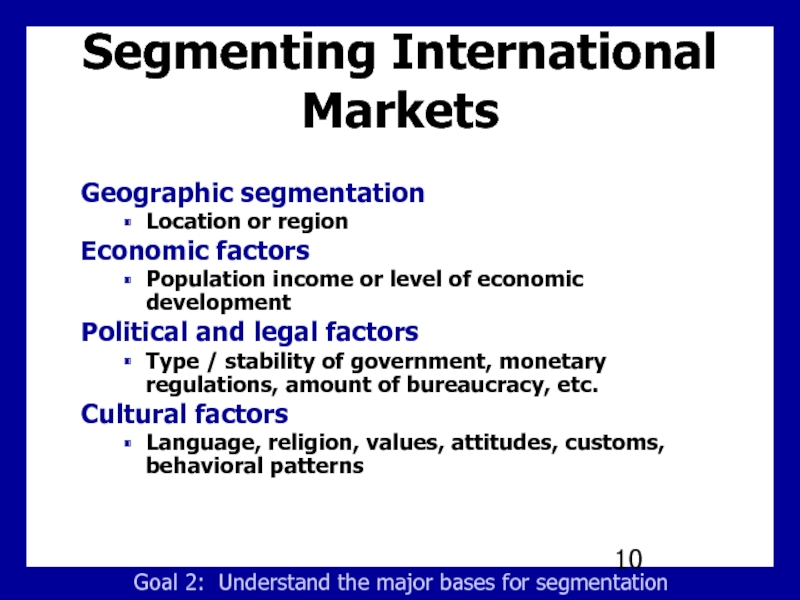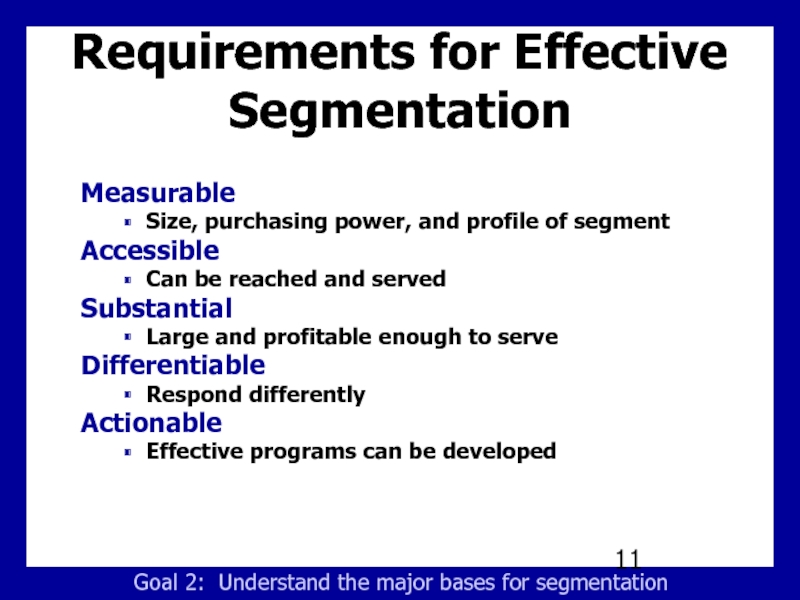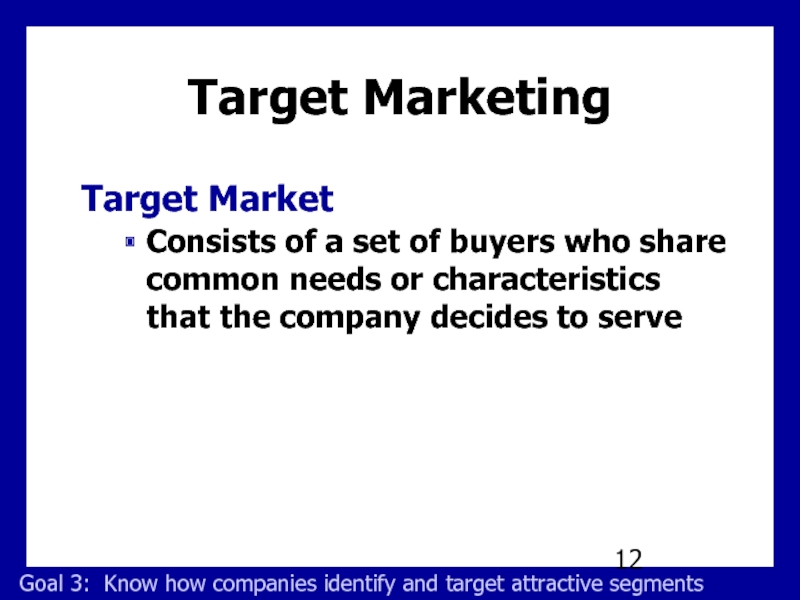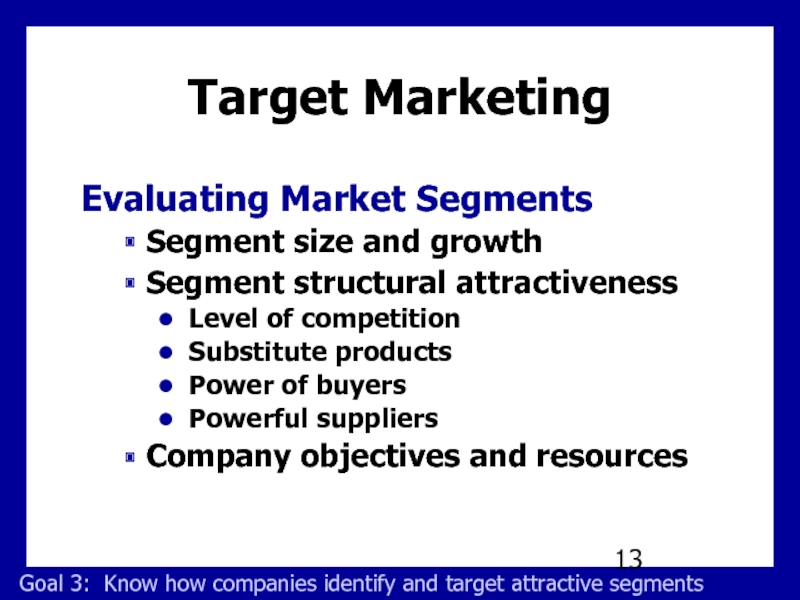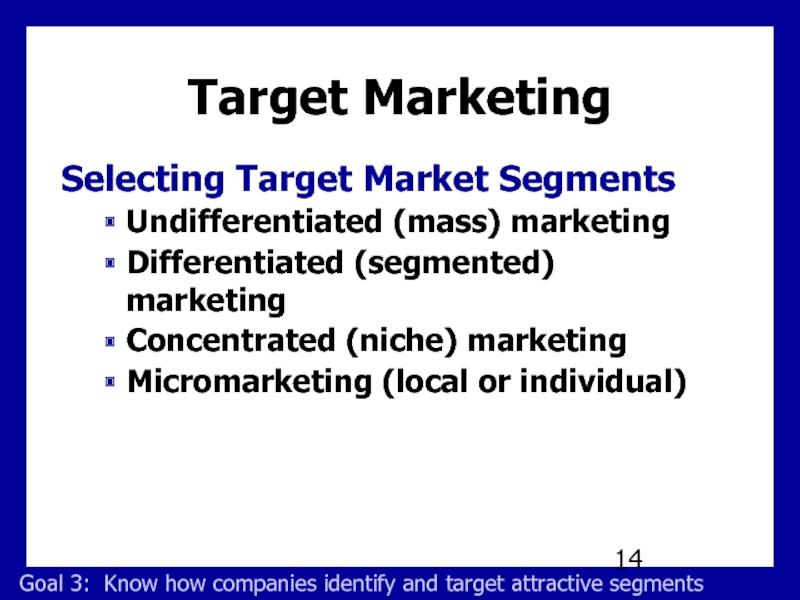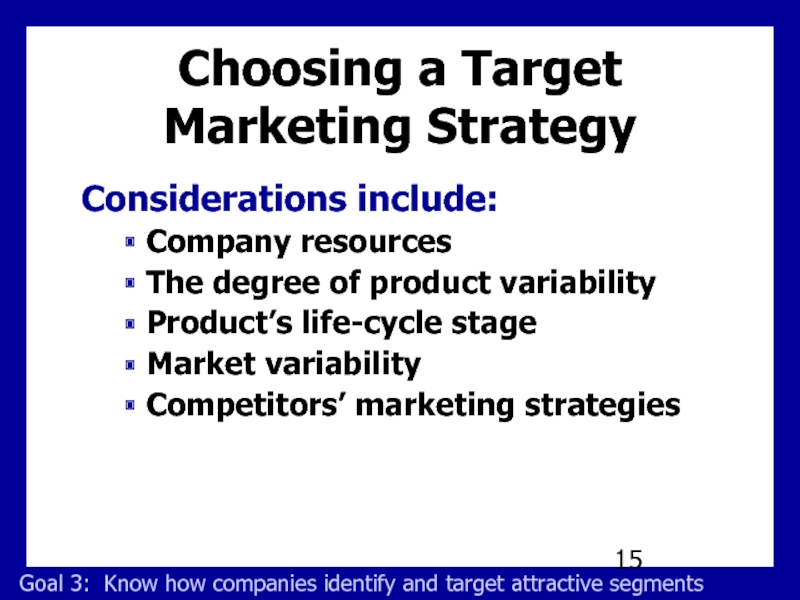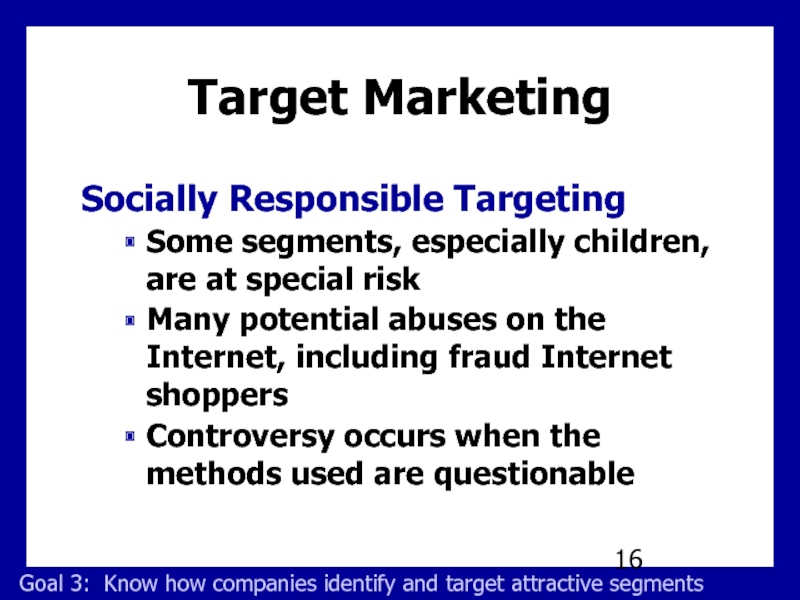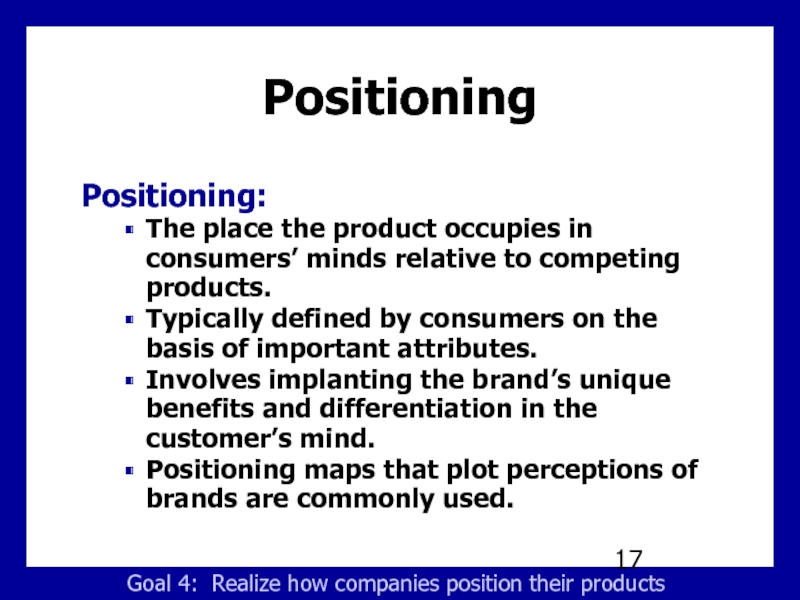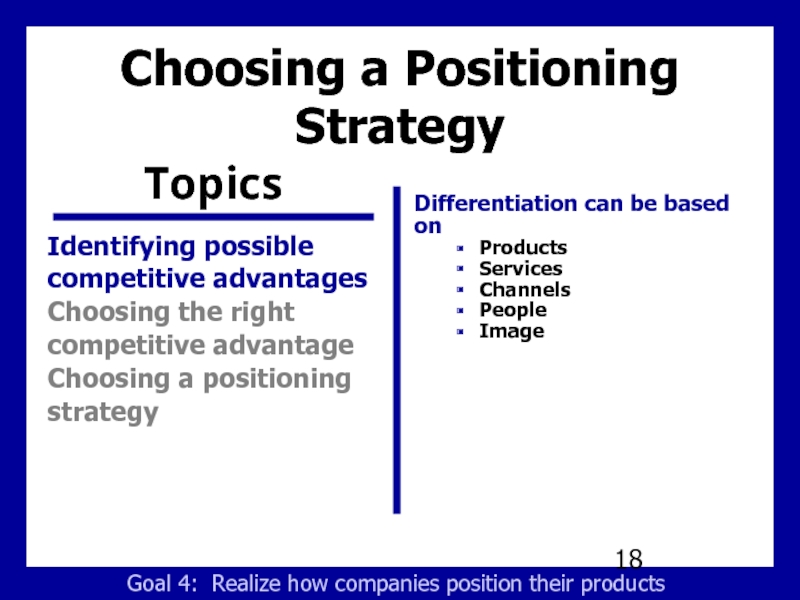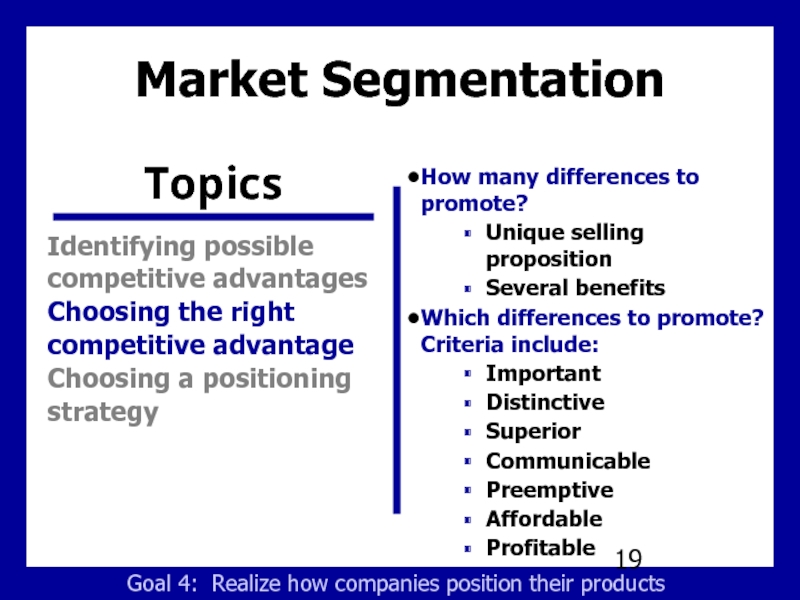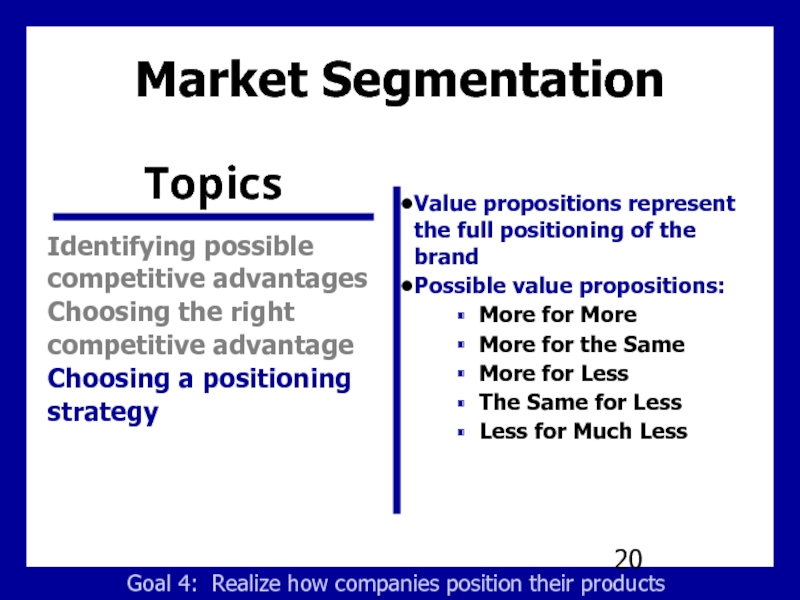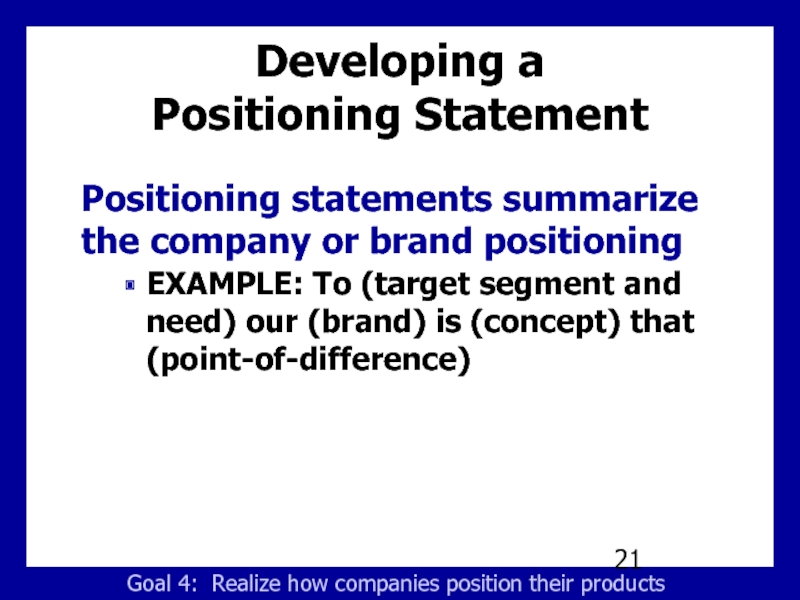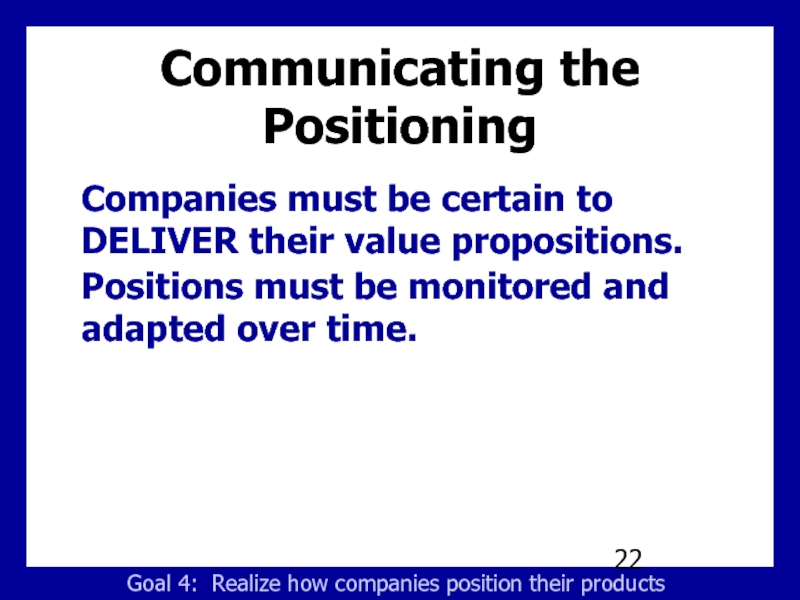Chapter 7
- Главная
- Разное
- Дизайн
- Бизнес и предпринимательство
- Аналитика
- Образование
- Развлечения
- Красота и здоровье
- Финансы
- Государство
- Путешествия
- Спорт
- Недвижимость
- Армия
- Графика
- Культурология
- Еда и кулинария
- Лингвистика
- Английский язык
- Астрономия
- Алгебра
- Биология
- География
- Детские презентации
- Информатика
- История
- Литература
- Маркетинг
- Математика
- Медицина
- Менеджмент
- Музыка
- МХК
- Немецкий язык
- ОБЖ
- Обществознание
- Окружающий мир
- Педагогика
- Русский язык
- Технология
- Физика
- Философия
- Химия
- Шаблоны, картинки для презентаций
- Экология
- Экономика
- Юриспруденция
Segmentation, targeting and positioning. Building the right relationships with the right customers. Chapter 7 презентация
Содержание
- 1. Segmentation, targeting and positioning. Building the right relationships with the right customers. Chapter 7
- 2. Learning Goals Learn the three steps of
- 3. Sells multiple brands within the same product
- 4. Steps in market segmentation, targeting and positioning
- 5. Definition Market Segmentation: Dividing a market into
- 6. Segmenting Consumer Markets Geographical segmentation Demographic segmentation
- 7. World region or country U.S.
- 8. Demographic Segmentation Variables Age Gender Family
- 9. Occasions Benefits User Status Attitude Toward
- 10. Segmenting Business Markets Demographic segmentation Industry, company
- 11. Segmenting International Markets Geographic segmentation Location
- 12. Requirements for Effective Segmentation Measurable Size,
- 13. Target Marketing Target Market Consists of a
- 14. Target Marketing Evaluating Market Segments Segment size
- 15. Target Marketing Selecting Target Market Segments Undifferentiated
- 16. Choosing a Target Marketing Strategy Considerations include:
- 17. Target Marketing Socially Responsible Targeting Some
- 18. Positioning Positioning: The place the product occupies
- 19. Identifying possible competitive advantages Choosing the right
- 20. Market Segmentation How many differences to promote?
- 21. Market Segmentation Value propositions represent the full
- 22. Developing a Positioning Statement Positioning
- 23. Communicating the Positioning Companies must be certain
Слайд 1Segmentation, Targeting, and Positioning Building the Right Relationships with the Right
Слайд 2Learning Goals
Learn the three steps of target marketing, market segmentation, target
Understand the major bases for segmenting consumer and business marketing strategy
Know how companies identify attractive market segments and choose target marketing strategy
Realize how companies position their products for maximum competitive advantage in the marketplace
Слайд 3Sells multiple brands within the same product category for a variety
Brands feature a different mix of benefits and appeal to different segments
Has also identified different niches within certain segments
Product modifications are useful: Tide offers seven different product formulations to serve different niches’ needs
Case Study
Procter & Gamble
Слайд 4Steps in market segmentation, targeting and positioning
Market Segmentation
Identify bases for segmenting
Develop segment profiles
Target Marketing
Develop measure of segment attractiveness
Select target segments
Market Positioning
Develop positioning for target segments
Develop a marketing mix for each segment
Goal 1: Learn the three steps of target marketing
Слайд 5Definition
Market Segmentation:
Dividing a market into distinct groups with distinct needs, characteristics,
Goal 2: Understand the major bases for segmentation
Слайд 6Segmenting Consumer Markets
Geographical segmentation
Demographic segmentation
Most popular segmentation
Psychographic segmentation
Lifestyle, social class, and
Behavioral segmentation
Goal 2: Understand the major bases for segmentation
Слайд 7
World region
or country
U.S. region
State
City
Neighborhood
City or
metro size
Density
Climate
Geographic Segmentation
Variables
Goal 2:
Слайд 8
Demographic Segmentation Variables
Age
Gender
Family size
Family life cycle
Income
Occupation
Education
Religion
Race
Generation
Nationality
Goal 2: Understand the major bases
Слайд 9
Occasions
Benefits
User Status
Attitude Toward the Product
User Rates
Loyalty Status
Readiness Stage
Behavioral Segmentation
Variables
Goal 2:
Слайд 10Segmenting Business Markets
Demographic segmentation
Industry, company size, location
Operating variables
Technology, usage status, customer
Purchasing approaches
Situational factors
Urgency, specific application, size of order
Personal characteristics
Buyer-seller similarity, attitudes toward risk, loyalty
Goal 2: Understand the major bases for segmentation
Слайд 11Segmenting International Markets
Geographic segmentation
Location or region
Economic factors
Population income or level of
Political and legal factors
Type / stability of government, monetary regulations, amount of bureaucracy, etc.
Cultural factors
Language, religion, values, attitudes, customs, behavioral patterns
Goal 2: Understand the major bases for segmentation
Слайд 12Requirements for Effective Segmentation
Measurable
Size, purchasing power, and profile of segment
Accessible
Can be
Substantial
Large and profitable enough to serve
Differentiable
Respond differently
Actionable
Effective programs can be developed
Goal 2: Understand the major bases for segmentation
Слайд 13Target Marketing
Target Market
Consists of a set of buyers who share common
Goal 3: Know how companies identify and target attractive segments
Слайд 14Target Marketing
Evaluating Market Segments
Segment size and growth
Segment structural attractiveness
Level of
Substitute products
Power of buyers
Powerful suppliers
Company objectives and resources
Goal 3: Know how companies identify and target attractive segments
Слайд 15Target Marketing
Selecting Target Market Segments
Undifferentiated (mass) marketing
Differentiated (segmented) marketing
Concentrated (niche) marketing
Micromarketing
Goal 3: Know how companies identify and target attractive segments
Слайд 16Choosing a Target Marketing Strategy
Considerations include:
Company resources
The degree of product variability
Product’s
Market variability
Competitors’ marketing strategies
Goal 3: Know how companies identify and target attractive segments
Слайд 17Target Marketing
Socially Responsible Targeting
Some segments, especially children, are at special
Many potential abuses on the Internet, including fraud Internet shoppers
Controversy occurs when the methods used are questionable
Goal 3: Know how companies identify and target attractive segments
Слайд 18Positioning
Positioning:
The place the product occupies in consumers’ minds relative to competing
Typically defined by consumers on the basis of important attributes.
Involves implanting the brand’s unique benefits and differentiation in the customer’s mind.
Positioning maps that plot perceptions of brands are commonly used.
Goal 4: Realize how companies position their products
Слайд 19Identifying possible competitive advantages
Choosing the right competitive advantage
Choosing a positioning strategy
Differentiation
Products
Services
Channels
People
Image
Topics
Choosing a Positioning Strategy
Goal 4: Realize how companies position their products
Слайд 20Market Segmentation
How many differences to promote?
Unique selling proposition
Several benefits
Which differences to
Important
Distinctive
Superior
Communicable
Preemptive
Affordable
Profitable
Topics
Identifying possible competitive advantages
Choosing the right competitive advantage
Choosing a positioning strategy
Goal 4: Realize how companies position their products
Слайд 21Market Segmentation
Value propositions represent the full positioning of the brand
Possible value
More for More
More for the Same
More for Less
The Same for Less
Less for Much Less
Topics
Identifying possible competitive advantages
Choosing the right competitive advantage
Choosing a positioning strategy
Goal 4: Realize how companies position their products
Слайд 22Developing a
Positioning Statement
Positioning statements summarize the company or brand positioning
EXAMPLE:
Goal 4: Realize how companies position their products
Слайд 23Communicating the Positioning
Companies must be certain to DELIVER their value propositions.
Positions
Goal 4: Realize how companies position their products

